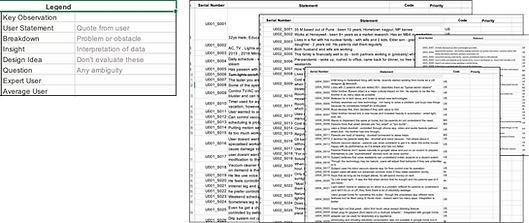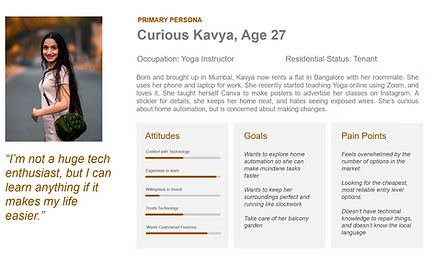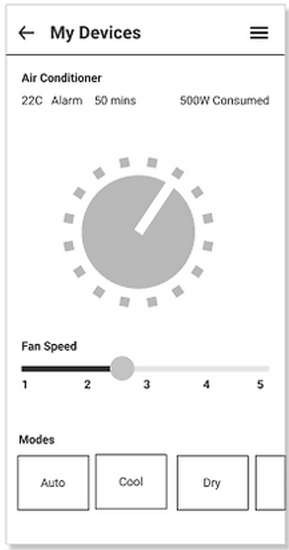A Product, Service & UX Designer.
Case Study #2
A Unified B2B & B2C Platform for Connecting Customers with Tailored Automation
As part of the Honeywell Automation Hackathon Challenge, I led UX design for SMART NEST, a platform built to fix the fragmented smart home experience.

Some sections of this portfolio have been intentionally blurred or modified to honor NDAs and protect sensitive client information. For a more detailed walkthrough, please feel free to get in touch.
The Challenge: A Frustrating Smart Home Experience
Sarah, a young professional, recently moved into her new apartment. Excited to embrace smart home technology, she purchased smart lights, security cameras, and a thermostat from different brands. But her excitement quickly turned into frustration:
1. Each device required a separate app, making control complicated.
2. Some devices wouldn’t integrate, creating a disjointed experience.
3. Finding a trusted local vendor for setup and troubleshooting was a hassle.
"Why isn’t there a single app that simplifies all of this?" Sarah wondered.
Sarah’s pain points weren’t unique. Through my research, I discovered that many users shared similar struggles. This was the gap SMART NEST aimed to fill a seamless, all-in-one home automation platform that integrates devices, simplifies control, and connects users with local vendors.
Leading the UX Vision
As part of the Honeywell Automation Hackathon Challenge, our cross-functional team of four set out to redefine the smart home experience.
As the UX Lead, I was responsible for User research & interviews to uncover pain points. Creating personas & journey maps to inform design. Designing wireframes & prototypes for testing. Iterating based on usability feedback for an intuitive experience. Our goal is to make home automation accessible, intuitive, and frustration-free.
Understanding Users
What Do People Really Want?
To ensure we were solving real problems, I conducted 20+ user interviews across different tech comfort levels.
-
Tech Enthusiasts – Love smart tech but frustrated by lack of integration.
-
Tech Skeptics – Wary due to security concerns and complexity.
-
Casual Users – Overwhelmed by too many apps and settings.
Graphical imagery leads to a greater understanding of the topic.
Work Models


Consolidated all the interpretations in one file and converted all are raw notes into polished with all the details that were captured during interviews. Also captured the Key Insights, Observations, Design Ideas and User Statements.


Interpreting the interviews alone was insufficient, as each interview represented just one individual's perspective, often colored by personal biases and specific focus points. To uncover broader patterns and opportunities for improvement, it was essential to consolidate these varied perspectives. By connecting the dots from each observation and drawing inferences, I gained a more comprehensive view. These insights were crucial for identifying root problems faced by users and ultimately developing effective solutions.
Key Insights & Core Personas
-
Users wanted one unified platform instead of juggling multiple apps.
-
Personalization & simplicity were crucial some wanted full control, while others preferred a minimal, guided experience.
-
Trust in local vendors mattered users needed reliable setup and support.
-
Seamless device integration across brands.
-
A marketplace to help users find, buy, and install smart solutions.




Bringing the Vision to Life
I created low-fidelity wireframes to test core interactions. Early usability testing revealed key challenges:
-
Confusing Navigation – Users struggled to switch between the marketplace and dashboard. Solution: Introduced a bottom navigation bar for seamless switching.
-
Missing Quick Controls – Users expected on/off toggles for rooms. Solution: Added dedicated room-based controls for quick actions.
Given the niche nature of smart home users, we opted for expert heuristic evaluation instead of large-scale user testing. This approach helped us refine key areas:
-
Redesigned Home Screen – Prioritized key features for intuitive access.
-
Improved Personalization – Made recommendations more prominent.
-
Refined Dashboard UI – Enhanced readability & quick controls.
A Future-Ready Smart Home Experience: Smart, Seamless, Scalable
Sarah, our user, no longer juggles multiple apps. With SMART NEST, she can:
-
Control all her devices from one place.
-
Get personalized recommendations tailored to her needs.
-
Trust local vendors for seamless setup & support.
-
Tested the final prototype, 90% of users found it intuitive & valuable.

Key Learnings
-
Ask the right questions, the right way — Effective research is not only about gathering data but also about shaping questions to elicit fair, unbiased, and actionable answers.
-
Facilitate cross-functional collaboration — Bringing product, engineering, business, and design together early ensures alignment, faster decision-making, and richer solutions.
-
Leverage rapid ideation tools — In time-bound environments like hackathons, using fast, lightweight tools enables quick prototyping and iteration without getting stuck in traditional process bottlenecks.
-
Balance speed with clarity — Moving fast is essential, but defining a clear problem statement first ensures ideas remain focused and impactful.









